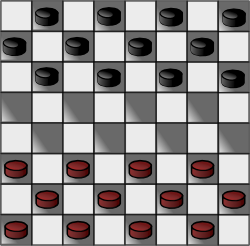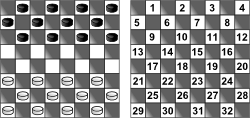 This popular game is known as Checkers in the United States, and Draughts in much of the rest of the world. It is a two-player game played on a board made up of 64 alternately-colored squares, eight to a side.
This popular game is known as Checkers in the United States, and Draughts in much of the rest of the world. It is a two-player game played on a board made up of 64 alternately-colored squares, eight to a side.
The rules to the game are relatively simple, though strategy can be deeper than you might expect. The following overview of how to play Checkers is intended to introduce you to the basic concepts of the game; further study would be wise for serious players.
How To Play Checkers (Draughts)
 Checkers is played on a board made up of 64 alternately-colored squares, eight to a side. All gameplay occurs on squares of a single color – usually the darker one. By tradition, the dark squares are called "green" and the light squares are called "buff", though in commercial checkers sets, colors can vary quite a bit – red/black, white/black, brown/black, etc.
Checkers is played on a board made up of 64 alternately-colored squares, eight to a side. All gameplay occurs on squares of a single color – usually the darker one. By tradition, the dark squares are called "green" and the light squares are called "buff", though in commercial checkers sets, colors can vary quite a bit – red/black, white/black, brown/black, etc.
Likewise, the checker pieces can vary between sets – sometimes black/red, othertimes black/white, or other colors. Reference books usually refer to them as "Black" and "White".
Setup
Each player has 12 pieces (also known as "men"). The players sit on opposite sides of the game board. The pieces are placed on the dark squares in the three rows nearest the player.
The object of the game is to eliminate all of your opponent's pieces from the board, before they manage to do the same to you.
The red player makes the first move. Players alternate red an black in subsequent games.
Gameplay
Each piece may move forward diagonally either one space (if the space is empty) [Example #1] or two spaces (if the adjacent space is occupied by an opponent's man, and the space beyond it is empty) [Example #2]. If a piece "jumps over" an opposing man, that man is "captured" and removed from the board.
If your first move resulted in a capture, and you land in a position to jump another of your opponent's pieces, jump (and capture) that piece as well [Example #3]. A sequence of several moves may thus be strung together, resulting in the capture of more than one of your opponent's men in a single move, an often-crushing blow to your opponent's hopes.

 When one of your pieces reaches the last row of your opponent's board (called "King's Row"), it is transformed into a "King", and granted a special power – it can now move both forward and back! A king is usually denoted by stacking two regular pieces, and is sometimes called "kinging" or "crowning".
When one of your pieces reaches the last row of your opponent's board (called "King's Row"), it is transformed into a "King", and granted a special power – it can now move both forward and back! A king is usually denoted by stacking two regular pieces, and is sometimes called "kinging" or "crowning".
Play continues until all of one player's pieces are eliminated, or blocked from moving.
Notes
- If an opponent's piece is adjacent to yours, and there is an empty space beyond it, then you must jump over his piece and remove it from the board, and must continue jumping as long as there are moves to be made. If a player refuses to perform a jump when one is available, he forfeits the game.
- If more than one separate jump is available, you have the choice of which move to take.
- If a single piece reaches the opponent's kings row by jumping, it must stop to be crowned, and may not continue moving in the same turn, even if additional plays are available.
- If neither player is able to move a piece (or if both players agree that the game is unwinnable), the game is declared a "draw", and is replayed.
- These rules summarize "American Checkers"; "English Draughts" is basically the same. For other checkers variations, see the list in the next section.
Checkers Variations
Although "American Checkers" (or "Standard Checkers") is the most commonly played checkers in the United States, there are actually quite a large number of variations played around the world. The most popular is undoubtedly "International Checkers" (or "International Draughts"), but there are numerous regional and country-specific versions as well:
- Armenian Draughts (Tama)
- Brazilian Checkers
- Canadian Checkers
- Chesckers
- Continental Checkers
- Diagonal Checkers
- German Checkers
- Fox and Geese
- Frisian Checkers
- Giveaway Checkers
- Italian Checkers
- International Checkers
- Pool Checkers
- Russian Checkers
- Spanish Checkers
- Turkish Checkers
Checkers Notation
 You'll find, that when Checkers is discussed in Checkers Books and online, the following is the most commonly used notation:
You'll find, that when Checkers is discussed in Checkers Books and online, the following is the most commonly used notation:
Note that in the diagram, pieces are shown on the light squares rather than the dark squares.
Squares on the board which may be occupied by checkers pieces are numbered 1 to 32, starting at the upper left. That notation is used by most Checkers Software to record and play back games, and to aid in analysis and strategy discussions.
Checkers Strategy Tips
- It is usually better to play your men towards the middle of the board, rather than playing to the edges, since this gives you the greatest number of choices for movement. On the other hand, don't allow your men to become too concentrated in the center.
- Take your time and think through your moves; don't allowed yourself to be pressured by your opponent to "hurry up".
- Avoid dividing your pieces if possible, and as your numbers dim, concentrate them in one area if you can.
- In planning your own strategy, don't neglect to take into account your opponent's probable plans.
- Don't be afraid to sacrifice some of men in order to force your opponent into moves which thwart his probable plans. See if you can force your opponent into losing two or more checkers at once.
- When losing some of your pieces seems inevitable, take out as many of your opponent's men as possible in the bargain.
- When playing against a superior opponent, note their opening moves, and copy their tactics. Likewise, note their defenses against the most common opening gambits.
- The pieces on your king row are your last line of defense; don't move them too soon!
- Every move should have a purpose.
- Obviously, kings are most valuable pieces, so reaching your opponent's king row is important.
- Your game will improve faster if you compete against more experienced opponents.
Checkers Rule Links
To learn more about the game, consult one of the many fine Checkers Books, or the web sites below, which provide additional rule and strategy guides.
- ItsYourTurn Checkers Rules
ItsYourTurn.com provides these rules for American checkers (and some variations). They also provide rules for International Checkers. - Masters Traditional Games: Rules of Draughts
These rules are provided by Masters Traditional Games, an Internet shop. These rules are comprehensive instructions for friendly play. They are not a complete set of standard regulations encompassing all situations that might be encountered. - The Standard Laws of Checkers
These rules, from Jim Loy's Checkers Pages, describes the official rules of the game, with his own annotations. Jim also provides a more concise Basic Rules page. - Wikipedia English Draughts Rules
Rules for English Draughts (more commonly known as checkers), from the free online encyclopedia.
